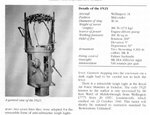Does anyone know if AVROs ever did any testing of adding an American Sperry Ball type ventral turret to the Lancaster? Eventually a Martin mid upper turret was adopted.
Considering that the periscopic ventral turret was a failure the manned Sperry turret would seem to be an obvious choice. It certainly would have been a surprise to your jaded German Ju88G6 pilot.
lordish
Considering that the periscopic ventral turret was a failure the manned Sperry turret would seem to be an obvious choice. It certainly would have been a surprise to your jaded German Ju88G6 pilot.
lordish


